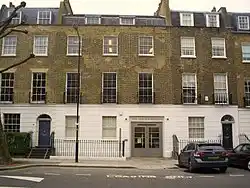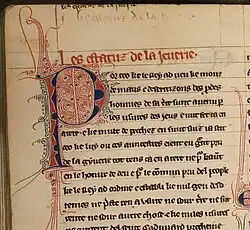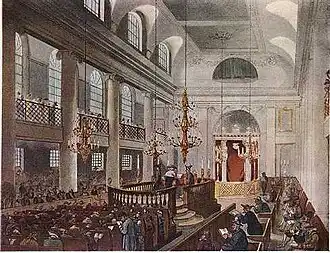
The Jewish Museum of London is a registered charity in England dedicated to the history and heritage of the Jewish community in England and Jewish life more broadly. The Jewish community in England dates back to the eleventh century when William the Conqueror invited Jewish people to his new country from the continent in order to avail of their financial and commercial skills. In the thirteenth century they faced persecution and eventually an expulsion order in 1290, but in more modern times Britain was comparatively more tolerant of Jewish people than many of its continental peers like Germany and France. Thus, the Jewish population within England swelled to nearly 400,000 people by the middle of the twentieth century. Founded in 1932 by Jewish scholars living in England, the Jewish Museum has a particular focus on Jewish life, the Holocaust and the experience of Jews in London over the centuries.[1]
Research your ancestors on MyHeritage
History of the Jewish community in EnglandHistory of the Jewish community in England
Britain is located a long way from the Eastern Mediterranean and countries like Egypt, Cyprus and Turkey that were the first major sites of the Jewish diaspora in ancient times, once the Roman state began engaging in sustained discriminatory policies that drove many Jews from Judaea. There is consequently little or no evidence of any Jewish community to speak of in England in late antiquity or the first centuries of the medieval period. That only changed in 1070, when William the Conqueror, who had only recently become king after the invasion of England from his patrimony in Normandy in northern France and victory at the Battle of Hastings, invited some of the Jewish people of the continent to come and settle in England. In an enlightened move, William believed that the mercantile and commercial skills of Ashkenazic Jewish people in places like France and Germany would be of value in his new kingdom, even as Anti-Semitism was otherwise growing on the continent.[2]

William’s benign approach did not last for long. By the thirteenth century there were thousands of Jewish people living in London and England. There was also a growing backlash against their presence here. This was partly a byproduct of the growing Christian religiosity of the times, the era from the 1090s through to the 1290s being the age of the Crusades to the Holy Land and other, ultimately more successful, Crusades in the Baltic Sea region and Spain. A pogrom of Jewish people living in and around the city of York in northern England took place in the summer of 1190 in the midst of the Third Crusade, while King Edward I, a figure who led the Ninth Crusade to the Holy Land in the early 1270s, subsequently returned home to England and began systematically attacking England’s Jewish community.[3] In 1275 he introduced a Statute of Jewry (Statutum de Judaismo), legislation which placed major restrictions on Jewish economic activity. Then in 1290 he issued a blanket expulsion order which commanded all Jewish people in England to leave the country.[4] With that most left for the continent and these communities would eventually migrate eastwards towards Poland and tolerance.[5]
The Jewish community in England revived intermittently in the centuries that followed. There was a sufficient number of Jews in Bristol, at that time the second city of the country after London itself, for the municipal authorities to try and banish them in the early seventeenth century. A half a century later, Oliver Cromwell, no fan of religious toleration when it came to Roman Catholics, but a ruler who viewed the adherents of Judaism as the spiritual kin of his own radical Reformed Protestantism, made it known, like William the Conqueror over half a millennium earlier, that Europe’s Jews would find tolerance in England yet again. Hence the Jewish community began to grow in England and Britain.[6]
It continued to expand in the eighteenth, nineteenth and early twentieth centuries, with a particular concentration of Jewish people in London’s East End. While Anti-Semitism was still a feature of English and British life in modern times, it was not as pronounced here as in countries like Russia, France and Germany in the period between 1870 and 1945. Thus, by the time the Second World War broke out in 1939 there were nearly 400,000 Jewish people in England. While that number has fallen with the growth of the Israeli state since the late 1940s, there are still over quarter of a million Jews in England today. The Jewish Museum of London captures their history.[7]
The Jewish Museum of LondonThe Jewish Museum of London
The Jewish Museum of London was first founded back in 1932 in Bloomsbury in the English capital. It was established on the initiative of Professor Cecil Roth and several other leading scholars of Jewish heritage in Britain at the time. The Jewish Museum became a site where the wider history of the Jewish people was celebrated, often with a specific focus on the life of the Jewish community in England and Britain since medieval times. Inevitably, after the Second World War many new exhibits on the history of the Holocaust or Shoah were developed. In 1995 the Museum moved from its original site at Bloomsbury to Camden Town in north London.[8]
Unfortunately the Museum ran into numerous funding and organizational issues during the Covid-19 pandemic, as revenue from visitors to the museum dried up. This placed it in financial difficulty, which was then compounded by the inflation and energy crisis of 2022 and 2023. Owing to these issues, the Museum had to close its doors in the summer of 2023. The organization is still functioning and its collections can be consulted online. It is also hoped that the physical museum will be able to reopen within five years once funding has been obtained and a long-term sustainable model developed for its future development.[9]
Genealogical research at the Jewish Museum of LondonGenealogical research at the Jewish Museum of London

The Jewish Museum has a wide range of exhibits which bring to life the experience of Jewish people in England and Britain over the centuries. These include books, drawings, ceremonial prints, clothing, religious objects and even some of the religious ornaments from the Great Synagogue of London, a building which was largely destroyed in the German Blitz of the city in 1941.[10] There is also an extensive library and archives within the Museum. Workshops and other events are often held here and lectures provided, some aimed at genealogists and family historians with Jewish heritage in England and Britain.[11]
See alsoSee also
Explore more about the Jewish community in BritainExplore more about the Jewish community in Britain
- United Kingdom, Jewish Death and Burial Records records collection on MyHeritage
- Mandatory Palestine Naturalization Applications, 1937-1947 records collection on MyHeritage
- Worldwide Jewish Burial Registry from JewishGen records collection on MyHeritage
- Researching Your Jewish Ancestors at Legacy Family Tree Webinars
- Jewish Genealogy with JewishGen.org at Legacy Family Tree Webinars
References
- ↑ https://jewishmuseum.org.uk/
- ↑ https://www.nationalarchives.gov.uk/education/resources/jews-in-england-1066/
- ↑ https://www.english-heritage.org.uk/visit/places/cliffords-tower-york/history-and-stories/massacre-of-the-jews/
- ↑ https://www.nationalarchives.gov.uk/education/resources/jews-in-england-1290/
- ↑ Sholom A. Singer, ‘The Expulsion of the Jews from England in 1290’, in The Jewish Quarterly Review, Vol. 55, No. 2 (October, 1964), pp. 117–136.
- ↑ https://www.thejc.com/lets-talk/the-strange-tale-of-oliver-cromwells-unlikely-partnership-with-a-jew-u8yb1oto
- ↑ https://www.thehistoryoflondon.co.uk/londons-jewish-community-in-the-19th-century-part-1-their-arrival/
- ↑ https://jewishmuseum.org.uk/2023/12/12/jewish-museum-london-on-the-move-project-awarded-heritage-fund-grant/
- ↑ https://www.bbc.co.uk/news/uk-england-london-66357950
- ↑ https://jewishmuseum.org.uk/collections/
- ↑ https://jewishmuseum.org.uk/events/

